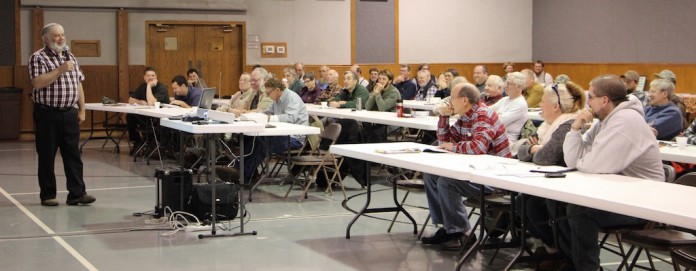
FREDERICKSBURG, Ohio — Maple syrup is one of the fastest-growing sectors of the locally grown food movement. “How much more local can you get,” than driving right to the sugar house to purchase fresh maple syrup? asked Gary Graham, OSU Extension educator in Holmes County and state maple syrup specialist.
Producers who attended Maple Days, Jan. 22, in Fredericksburg, Ohio, learned how to enhance their maple syrup production, new products to consider making and the importance of marketing that finished product. Similar sessions were also held in Morrow and Geauga counties.
“It’s a chance to get producers together to see the latest technologies and learn tricks of the trade from other producers to make a better quality product,” said Graham.
Grading standards

During last year’s workshop, producers were introduced to a new grading system that went into effect in March 2015. The new system focuses more on the flavor of the finished product than the color. Graham said flavor resonates more with consumers than color and they are more apt to understand label descriptors of “delicate, mild and robust” versus, “dark, light and amber.”
In addition, all maple syrup will be considered grade A and fall under a classification of color and taste — golden, delicate; amber, rich; dark, robust; or very dark, strong. The international grading system makes grading uniform across the U.S. Ohio does not require producers to grade their maple syrup products, but Graham suggests they do. “Customers are a lot more food conscious today than in the past,” he said.
Graham also highlighted the importance of educating consumers on these new grading standards and suggested hanging posters in their sugar shacks or retail space to show the color/taste breakdown of the new standards. (Posters are available on the International Maple Syrup Institute website.)
“If you grade some of your syrup and bottle it, I think you are going to find people coming back for that specific taste,” said Graham.
Specialty products
Producers might also find their way back to a specific producer if they start adding maple candies to their product line. Not many hands went up when Stephen Childs, Cornell sugar maple program director and New York state maple specialist, asked how many producers already make maple candies, and no hands went up when he asked, “Who doesn’t want to make more money?”
The candies can be a time-consuming product — which he feels is why many have not taken on candy making — but with the right equipment, producers can make candy efficiently and possibly see an increase to their bottom line. Childs said the research team sold 2,000 pounds of soft maple candy during the New York State Fair. Research showed consumers preferred a medium or soft candy, that was smooth in texture and had a mild taste.
Production update
But to produce a specialty product, there has to be enough production to make those extra candies. Childs shared an update on the research Cornell has been doing on maple trees to increase production.
Creating a vacuum within the tree has shown to increase production by 5-8 percent during days of lower temperature. Childs also suggests that less is more when using this vacuum system, stating, “There is no reason to over tap your trees.”
Too many taps could lessen the strength of the vacuum created within the tree, he explained. Childs’ research team also determined that a smaller tubing of 3/16 inch — versus the standard 5/16 inch tube — creates a better vacuum.
Sanitation
Dan Milo, food safety supervisor at the Ohio Department of Agriculture, reminded producers the importance of a clean space when working with food products. A couple producers in the northeast Ohio area received surprise inspections, he added. Milo said producers can pass these inspections by having an enclosed space (for food production) free from rodents and other animals, keeping the space clean, and having a handwashing station.
Maple production
Ohio maple syrup production is on the rise in the state, but the numbers don’t show it. Graham and Cheryl Turner, USDA Ohio state statistician, stressed the importance of maple producers reporting their maple production and number of taps.
Of the 3.41 million gallons of syrup reported in the United States in 2015, Ohio only accounted for roughly 2 percent of that production — 115,000 gallons in 2015. All states that report maple syrup production showed an increase in production except for Ohio, which went down 12 percent.
“I really don’t think this is accurate,” said Turner, who encouraged producers to fill out their NASS surveys in order to accurately reflect the production in Ohio.
For many years, Ohio was ranked no. 4 in the nation for maple production, but falls to no. 8 in the most recent NASS update
“I know we are stronger,” Graham said.
Maple Nuggets
- According to Gary Graham, OSU Extension state maple syrup specialist, maple syrup is high in nutritional value. Pure maple syrup is a natural sweetener and is a good source of vitamins and minerals such as: magnesium, riboflavin, zinc, manganese, calcium and potassium.
- Ohio ranked No. 8 in maple syrup production in 2015, with 115,000 gallons and 440,000 taps reported. In 2014, Ohio produced 130,000 gallons and in 2013, 155,000 gallons. Graham and Cheryl Turner, USDA Ohio state statistician, believe this is an inaccurate reflection of Ohio maple syrup production.
- The new grading standard classifies maple syrup by color and taste: golden maple with a delicate taste, amber maple with a rich taste, dark maple with a robust taste and very dark maple with a strong taste.









